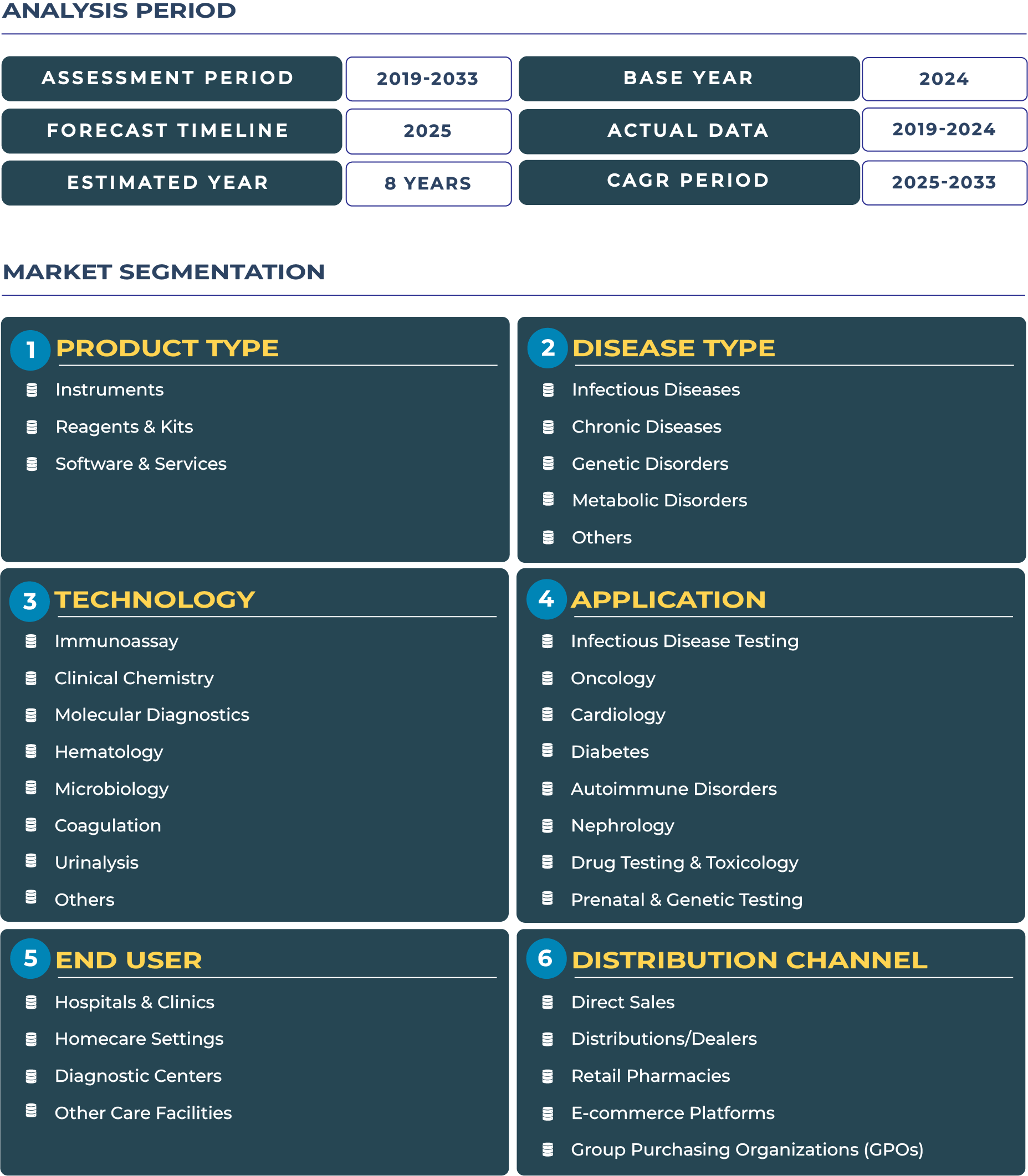Thailand In-vitro Diagnostic Market Outlook: Universal Healthcare as the Catalyst for Expanding Access and Innovation
Thailand’s commitment to universal healthcare coverage has not only revolutionized access to medical services but also transformed the country into a leading destination for affordable, high-quality healthcare in Southeast Asia. This foundational policy, coupled with a growing private hospital network and strategic government investments, has accelerated the advancement of the In-vitro Diagnostic (IVD) market. As Thailand positions itself as a healthcare leader under its “Thailand 4.0” vision, the diagnostics sector is embracing cutting-edge laboratory automation, advanced reagents, and cloud-based testing solutions to meet both domestic and international demands.
The Thailand In-vitro Diagnostic Market is projected to reach USD 761.7 million in 2025 and is expected to grow to USD 1,720.2 million by 2033, registering a strong CAGR of 10.7% during 2025, 2033. This remarkable growth trajectory is underpinned by the country’s inclusive healthcare model led by the Ministry of Public Health (MOPH), which ensures diagnostic access for over 99% of its citizens. Thailand’s extensive network of public hospitals and clinics, combined with the rising sophistication of private chains such as Bumrungrad International Hospital and Bangkok Dusit Medical Services, is fostering strong adoption of advanced diagnostic technologies. The increasing use of molecular testing, immunoassay systems, and real-time data-driven diagnostic software across hospitals and reference labs is redefining healthcare delivery, particularly in infectious disease control, chronic disease management, and oncology diagnostics.
Thailand’s medical tourism, which rebounded strongly post-pandemic, also acts as a significant contributor to the diagnostic sector. International patients seeking precision diagnostics for fertility, oncology, and metabolic testing increasingly prefer Thai facilities due to their balance of quality and cost-effectiveness. With the government actively investing in regional laboratory infrastructure and promoting technology transfer, the market outlook remains robust and strategically aligned with Thailand’s national bioeconomy goals.
Drivers & Restraints: Understanding the Forces Shaping Thailand Diagnostic Landscape
Strong Medical Tourism and Expanding Private Hospital Networks Fueling Growth
Thailand’s reputation as a global medical tourism hub drives strong demand for premium diagnostic services. Leading hospitals across Bangkok, Phuket, and Chiang Mai have invested in state-of-the-art molecular and hematology analyzers to cater to international patients seeking preventive diagnostics and treatment planning. Additionally, the Tourism Authority of Thailand (TAT) continues to promote wellness and medical tourism packages that incorporate pre-treatment diagnostic evaluations. The expansion of private hospital networks, along with increasing health insurance penetration, further broadens diagnostic accessibility. The growing adoption of reagent-based tests and clinical software integration supports operational efficiency, enhancing test reliability and throughput across facilities. These factors collectively strengthen Thailand’s position as a regional diagnostic excellence center.
Price Sensitivity and Regional Disparities Creating Growth Constraints
Despite the sector’s rapid growth, the Thailand In-vitro Diagnostic market faces challenges stemming from price sensitivity and regional inequalities. While metropolitan areas benefit from advanced laboratory setups and automation, rural provinces and island regions still struggle with logistics and supply chain inefficiencies. Transportation delays for reagents and calibration kits increase turnaround times and limit test reliability. Moreover, public healthcare procurement policies often prioritize cost over innovation, restricting adoption of higher-end diagnostic systems in some government hospitals. To address this, the government’s digital health strategy emphasizes the deployment of portable diagnostic instruments and cloud-linked testing services to bridge urban-rural healthcare divides, ensuring that the benefits of modern diagnostics reach all corners of the nation.
Trends & Opportunities: Evolving Diagnostics in the Era of Medical Tourism and Smart Healthcare
Medical Tourism Rebound and Outpatient Diagnostic Growth
The resurgence of medical tourism is redefining Thailand’s diagnostic ecosystem. Hospitals catering to international patients are increasingly integrating point-of-care testing, digital pathology, and next-generation sequencing (NGS) solutions to enhance clinical precision. The expansion of ambulatory and day surgery centers, particularly in Bangkok and Chonburi, is also driving the demand for rapid diagnostic tools and reagent automation systems. These developments highlight Thailand’s transition from conventional laboratory testing to more patient-centric, data-enabled diagnostics. The adoption of software-driven laboratory information systems (LIS) is further improving interoperability between diagnostic centers and hospitals, optimizing patient record management and workflow efficiency.
Clinical Collaboration and Tiered Pricing Opportunities for Market Expansion
Thailand IVD sector is ripe with opportunities for international collaborations and differentiated service offerings. Joint ventures between local hospitals and global diagnostic leaders have resulted in technology sharing and training partnerships that elevate laboratory standards. For example, leading international players are collaborating with Thai private hospital chains to co-develop testing protocols tailored to Southeast Asian patient profiles. The emergence of tiered pricing models, offering basic, advanced, and premium diagnostic packages, caters to the diverse purchasing power of both domestic and foreign patients. These strategies not only drive affordability but also support the sustainability of healthcare service providers. Furthermore, Thailand’s positioning as a logistics hub in ASEAN presents export potential for locally developed diagnostic reagents and test kits, amplifying its role within the regional medtech supply chain.
Competitive Landscape: Global and Domestic Leaders Strengthening Thailand’s Diagnostic Identity
The Thailand In-vitro Diagnostic landscape is highly competitive, featuring a blend of global giants and emerging domestic players. International leaders such as Abbott Laboratories, Siemens Healthineers, and Roche Diagnostics maintain strong distribution partnerships with Thai hospital groups, offering advanced diagnostic instruments and automation platforms. Local companies and regional distributors are increasingly focusing on reagents, consumables, and after-sales services to enhance their market share. Strategic collaborations, like those between local hospitals and diagnostic technology providers, are promoting the localization of manufacturing and R&D, reducing dependency on imports. Companies are also introducing medical tourism product lines that bundle diagnostics with elective procedures, capitalizing on Thailand’s strong medical reputation. By partnering with private chains and offering flexible service pricing, firms are optimizing accessibility and strengthening their foothold in Thailand’s fast-evolving healthcare ecosystem.







